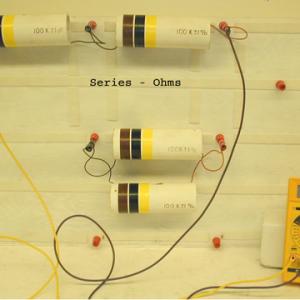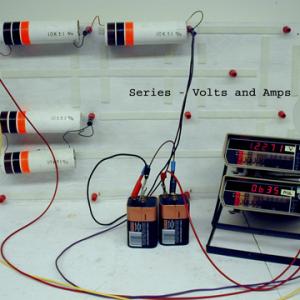College of Liberal Arts & Sciences
5F20.55 - Series and Parallel Resistors
Video Credti: Jonathan M. Sullivan-Wood
When using the Ohm meter the 100K resistors work best. With the series resistors you should have a reading of approx. 200 kilo-ohms, and with the parallel set the reading should be approx. 50 kilo-ohms.
NOTE: Do not use the Ohm Meter on a live circuit, as this will damage the meter.
We can also monitor Voltage and Current on these types of circuits. In this case the 10 K resistors seem to work the best. The voltage drops across the resistors can be measured as well as the current in each circuit.
- Leonardo Motta, Antonio Carlos Fontes dos Santos, "Symmetrical Cubic Arrangement of Resistors: An Experimental Approach", TPT, Vol. 61, #6, Sept. 2023, p. 461.
- Robert Ekey, Andrea Edwards, Roy McCullough, William Reitz, Brandon Mitchell, "A Fan-tastic Alternative to Bulbs: Learning Circuits with Fans", TPT, Vol. 55, #1, Jan. 2017, p. 13.
- Brandon Mitchell, Robert Ekey, Roy McCullough, William Reitz, "A Fan-tastic Quantitative Exploration of Ohm's Law", TPT, Vol. 56, #2, Feb. 2018, p. 75.
- "Correction", TPT, Vol. 53, # 5, May 2015, p. 262.
- Mikhail Kagan, "Comments on "Platonic Relationships Among Resistors", TPT, Vol. 53, # 4, April 2015, p. 196.
- Bradley Allen, Tongtian Liu, "Platonic Relationships Among Resistors", TPT, Vol. 53, # 2, Feb. 2015, p. 75.
- Hans Pfister, "The Sponge Resistor Model - A Hydrodynamic Analog to Illustrate Ohm's Law, the Resistor Equation R = pl/A and Resistors in Series and Parallel", TPT, Vol. 52, # 5, May 2014, p. 270.
- "Figuring Physics", TPT, Vol. 51, # 3, March 2013, p. 132.
- "Figuring Physics", TPT, Vol. 51, # 2, Feb. 2013, p. 74.
- William H. Baird, Caleb Richards, Pranav Godbole, ", Advanced Imaging of Elementary Circuits", TPT, Vol. 50, # 9, Dec. 2012, p. 561.
- Srdjan Jankovic, "Tracking Connections: An Exercise about Series and Parallel Resistances", TPT, Vol. 48, # 6, Sept. 2010, p. 391.
- Vandana Singh, "The Electron Runaround: Understanding Electric Circuit Basics Through a Classroom Activity", TPT, Vol. 48, # 5, May 2010, p. 309.
- "Figuring Physics", TPT, Vol. 45, # 3, March 2007, p. 179.
- Tony Minich, "Conceptualizing Series and Parallel Circuits Through 3-D Modeling", TPT, Vol. 43, # 7, Oct. 2005, p. 448.
- C. J. Efthimiou and R. A. Llewellyn, "Adding Resistances and Capacitances in Introductory Electricity", TPT, Vol. 43, # 6, Sept. 2005, p. 366.
- Ronald Brown, "Series and Parallel Resistors and Capacitors", TPT, Vol. 41, # 8, Nov. 2003, p. 483
- Thomas B. Greenslade Jr., "The Hydraulic Analogy for Electric Current", TPT, Vol. 41, # 8, p. 464, Nov. 2003.
- W. K. Ching, M. Erickson, P. Garik, P. Hickman, J. Jordan, S. Schwarzer, and L, Shore, "Overcoming Resistance with Fractals", TPT, Vol. 32, # 9, Dec. 1994, p. 546.
- "Figuring Physics", TPT, Vol. 31, # 3, Mar. 1993, p. 192.
- Robert A. Morse, "Feeling" Series and Parallel Resistance", TPT, Vol. 31, # 6, Sept. 1993, p. 347.
- Dale D. Long and Larry C. Bolling, "A Series / Parallel Circuit Demonstration", TPT, Vol. 19, # 1, Jan. 1981, p. 70.
- B. J. Pernick, "Resistors in Parallel", TPT, Vol. 18, # 2, Feb. 1980, p. 148.
- Mario Iona, "Mathematics or Common Sense", TPT, Vol. 18, # 6, Sep. 1980, p. 406.
- Robert P. Bauman, "Hydraulic Models for Electrical Circuit Elements", TPT, Vol. 18, # 5, May 1980, p. 378.
- Frederick A. Smith and Jerry D. Wilson, "Electrical Circuits and Water Analogies", TPT, Vol. 12, # 7, Oct. 1974, p. 396.
- Thomas B. Greenslade Jr., "A Nomograph for Resistors in Parallel", TPT, Vol. 40, #8, Nov. 2002, p. 458.
- Antoni Amengual, "The Intriguing Properties of the Equivalent Resistances of n Equal Resistors Combined in Series and in Parallel", AJP, Vol. 68, # 2, p. 175, Feb. 2000.
- Robert Ehrlich, "Why Toast Lands Jelly-Side Down", 9.2, A 3-4-5 Triangle of Resistance", p. 147.
- "Resistors in Series and Parallel", Selective Experiments in Physics, CENCO, 1962.
- "Cells in Series and Parallel", Selective Experiments in Physics, CENCO, 1962.
Disclaimer: These demonstrations are provided only for illustrative use by persons affiliated with The University of Iowa and only under the direction of a trained instructor or physicist. The University of Iowa is not responsible for demonstrations performed by those using their own equipment or who choose to use this reference material for their own purpose. The demonstrations included here are within the public domain and can be found in materials contained in libraries, bookstores, and through electronic sources. Performing all or any portion of any of these demonstrations, with or without revisions not depicted here entails inherent risks. These risks include, without limitation, bodily injury (and possibly death), including risks to health that may be temporary or permanent and that may exacerbate a pre-existing medical condition; and property loss or damage. Anyone performing any part of these demonstrations, even with revisions, knowingly and voluntarily assumes all risks associated with them.


